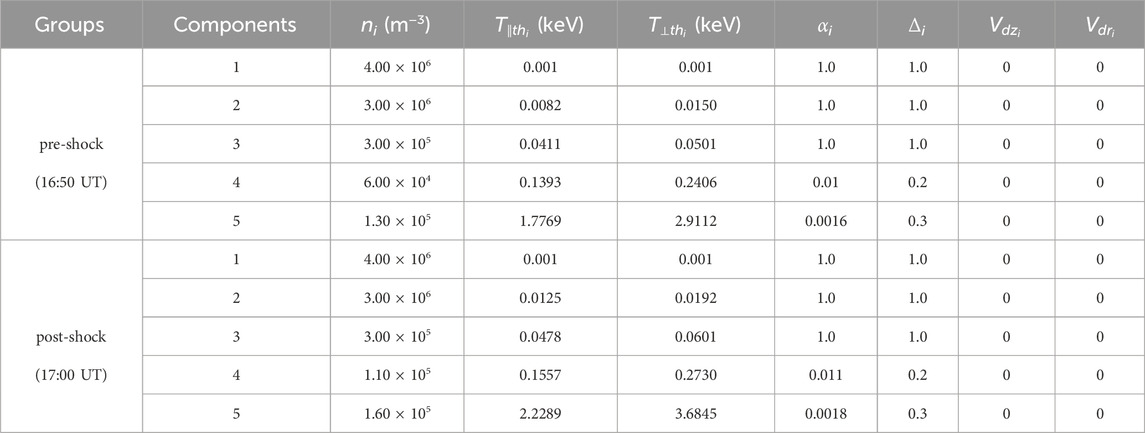- 1Planetary Environmental and Astrobiological Research Laboratory (PEARL), School of Atmospheric Sciences, Sun Yat-Sen University, Zhuhai, China
- 2Key Laboratory of Tropical Atmosphere-Ocean System, Sun Yat-Sen University, Ministry of Education, Zhuhai, China
- 3CAS Center for Excellence in Comparative Planetology, CAS Key Laboratory of Geospace Environment, Mengcheng National Geophysical Observatory, University of Science and Technology of China, Hefei, China
- 4Deep Space Exploration Laboratory, School of Earth and Space Sciences, University of Science and Technology of China, Hefei, China
- 5Collaborative Innovation Center of Astronautical Science and Technology, Hefei, China
Electron cyclotron harmonic (ECH) waves are electrostatic emissions frequently observed in the Earth’s magnetosphere. By precipitating magnetospheric hot electrons into the ionosphere, ECH waves play a critical role in the formation of diffuse aurora. Previous research has extensively investigated the strong dependence of ECH waves on the geomagnetic activities. In this study, we present the first report of the prompt response of ECH waves to an interplanetary shock on the basis of WIND and Van Allen Probes observations. Our observations and analyses demonstrate that the interplanetary shock compression can increase
1 Introduction
Electron cyclotron harmonic (ECH) waves are electrostatic emissions [1] that typically appear in thermal plasmas in the Earth’s magnetosphere [2–6]. They are usually observed as harmonic wave bands at frequencies between multiples of electron gyrofrequency (fce) [7–9]. Through cyclotron resonance, ECH waves are able to efficiently precipitate keV electrons from the magnetosphere to the ionosphere, contributing to the formation of diffuse aurora [10–16]. Therefore, a comprehensive understanding of the spatiotemporal distribution of ECH waves is required to forecast space weather [17–22].
The generation of ECH waves is proposed to be associated with Bernstein-mode instability driven by hot electron loss cone distributions [23,24]. These emissions with quasi-perpendicular wave vectors are confined near their source regions [24]. While extensive event and statistical studies have focused on the strong dependence of ECH waves on geomagnetic activities [3,25–27], none have directly established a link between ECH waves and solar wind disturbances. Interplanetary shocks, a subset of solar wind discontinuities frequently observed during active days [28–31], are highly geoeffective [32–35]. Numerous works have reported the immediate impacts of interplanetary shocks on magnetospheric plasma waves, including ultra low frequency waves, whistler-mode waves, magnetosonic waves, and EMIC waves [36–44]. Thus, the questions that naturally arise are whether and how an interplanetary shock can abruptly influence magnetospheric ECH waves.
In this study, using observations from the WIND [45] and Van Allen Probes missions [46], we present a representative ECH wave event during an interplanetary shock. The observations and analyses show that a shock compression can increase
2 Observation
Here we utilize the combined observations of WIND and Van Allen Probes to monitor the prompt response of ECH wave to an interplanetary shock. The Wind satellite operated in a halo orbit near the L1 Lagrange point. The Solar Wind Experiment (SWE) [47], the Magnetic Fields Investigation (MFI) [48], and the Three-Dimensional Plasma and Energetic Particle Investigation (3DP) [49] onboard WIND measured the solar wind parameters. The Van Allen Probes mission, comprising two identical probes (termed as RBSP-A and RBSP-B), orbited near the equator with perigees of approximately 0.1 RE and apogees of approximately 6 RE [46]. In this work, we mainly used the High Frequency Receiver (HFR) of the Electric and Magnetic Field Instrument Suite and Integrated Science (EMFISIS) instrument [50] to observe ECH waves. The HFR provided electric spectral intensities in the frequency range of 10–400 kHz in survey mode. Note the Waveform Frequency Receiver (WFR) of EMFISIS can provide electric spectral intensities at frequencies ranging from 10 Hz to 12 kHz. However, the WFR electric spectral data had been contaminated seriously above 5 kHz during the event in this work, and did not allow the clear observation of ECH waves. Following the method in Kurth et al. [51], we can derive the background plasma density Ne from the upper hybrid resonance frequency. The fluxgate magnetometer (MAG) of EMFISIS and the Electric Field and Waves (EFW) [52] instrument captured the background electromagnetic field. The Helium Oxygen Proton Electron (HOPE) Mass Spectrometer [53] of the Energetic particle, Composition and the Thermal (ECT) plasma suite [54] provided the electron flux data from several eV to
Figures 1A–G plot the solar wind parameters observed by WIND from 07 June 2014 to 11 June 2014. At 16:12 UT on 07 June 2014, a fast forward interplanetary shock was monitored, marked by abrupt increases in magnetic field strength, velocity, density, temperature, and dynamic pressure. According to the list by Chi et al. [55], there was an interplanetary coronal mass ejection (ICME) between approximately 19:00 UT on 08 June 2014 and 10:00 UT on 10 June 2014. This ICME exhibited typical features, including a declining velocity profile, low proton temperature, and bidirectional streaming of suprathermal electrons [56,57]. In a statistical sense, ICMEs c1might be the major driver of shocks c2during solar maximum, but shocks exist during solar minimum even if few ICMEs are present [58]. The large time lapse between the shock and the ICME front makes it uncertain to determine their relations. Whether this shock was driven by the ICME or a fast solar wind stream requires detailed studies in future and beyond the scope of this work. Approximately 41 min after its arrival in WIND data, the interplanetary shock with a drastic increase in solar wind dynamic pressure from 1 nPa to 6 nPa, compressed the Earth’s magnetosphere. This compression caused an increase of SYM-H index from −5 nT to 23 nT. Figure 1H shows the response of inner magnetospheric ECH waves to the interplanetary shock as observed by RBSP-A on 07 June 2014. Around the shock arrival, RBSP-A operated in the northern hemisphere (MLAT
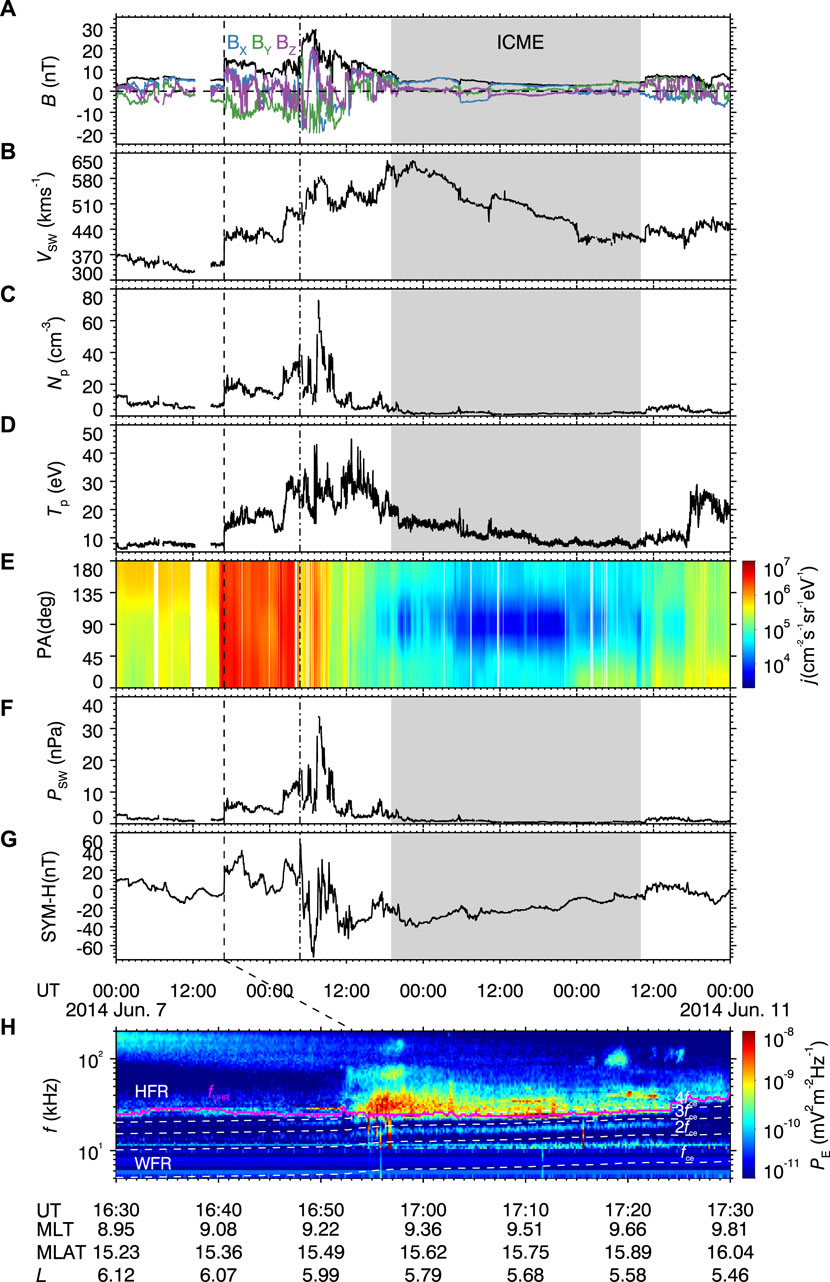
FIGURE 1. Overview of the ECH wave event on 07 June 2014: (A) Magnetic field magnitude Bt and components (BX, BY, BZ) in the geocentric solar magnetospheric (GSM) coordinate. (B) Bulk velocity Vsw. (C) Proton density Np. (D) Proton temperature Tp. (E) suprathermal electron flux j. (F) Solar wind dynamic pressure Psw. (G) Geomagnetic SYM-H index. (H) Zoom-in figure of Wave electric power spectra PE with overplotted electron gyrofrequency (fce) harmonics and upper hybrid resonance frequency (fUHR). The solar wind measurements by Wind satellite at
3 Physical explanations
Figure 2 presents the temporal evolutions of background electromagnetic fields and plasmas measured by RBSP-A during the event. Corresponding to the shock compression at 16:53 UT (marked by the vertical dashed line in Figure 2), the background magnetic field intensity increased from 200 nT to 223 nT. In contrast, the background plasma density Ne in the low-density plasma trough remained consistently below 10 cm−3 (which is dominant by the cold plasma) with no systematic variations after the shock. The interplanetary shock also induced ultralow-frequency waves with impulsive electric field amplitudes of 5 mV/m, subsequently resulting in a significant acceleration of hot electron fluxes above 0.1 keV. It is noteworthy that the similar responses of magnetospheric electron fluxes ranging from low energy to relativistic energy to interplanetary shocks have been reported by numerous studies [37,61–65]. However, the modulation of hot electron fluxes by the ULF wave can not be clearly observed in Figures 2D–F. Possible explanations for this could be the following: 1) rapid relaxation by magnetospheric plasma waves (ECH waves and chorus); 2) the comparable cadence (∼21 s) of HOPE instrument to ULF wave period (∼1–2 min). As reported by previous theoretical studies [23,24], the enhancement of hot electron fluxes could promote the wave instability by providing more free energy, and then lead to the wave intensification.
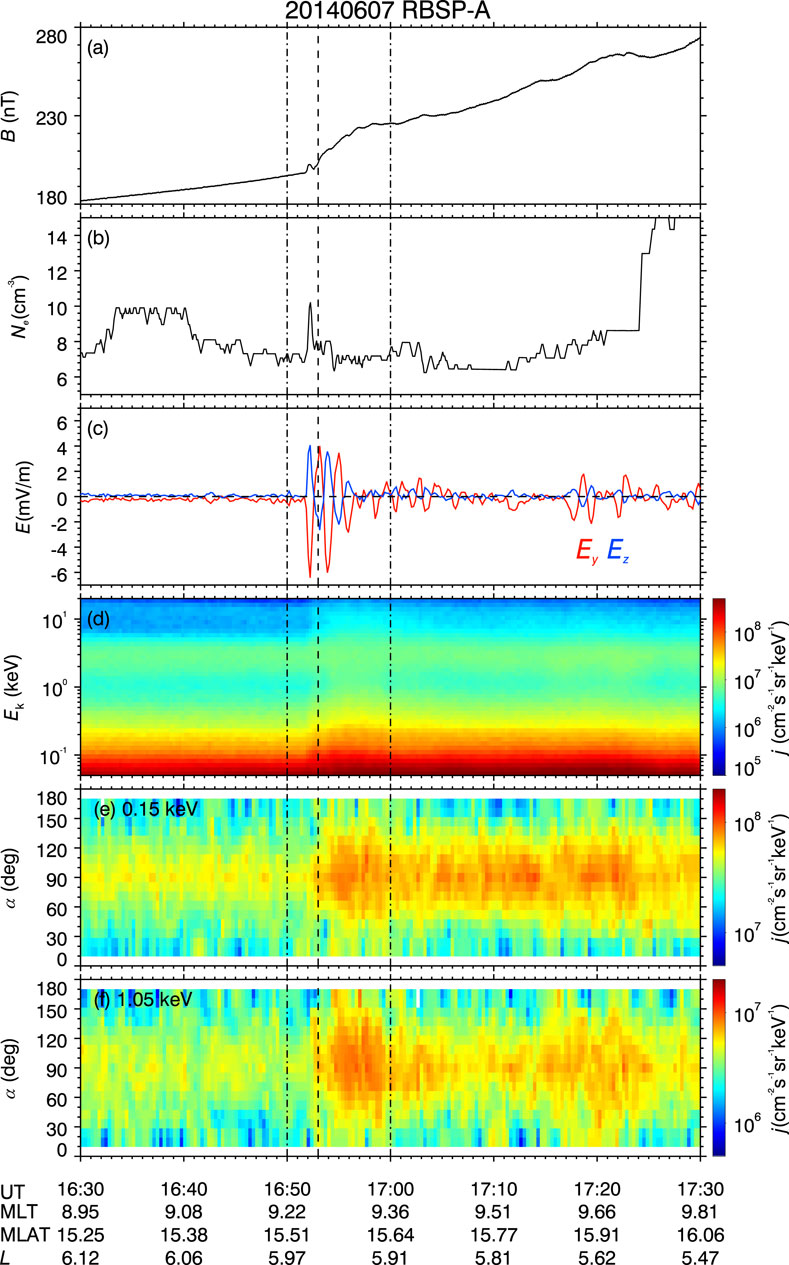
FIGURE 2. Temporal evolution of background fields and plasmas of 07 June 2014 event: (A) background magnetic field strength B. (B) Background plasma density Ne. (C) Electric field components in the modified geocentric solar ecliptic (mGSE) coordinate system. (D) electron spin-averaged differential flux j. (E,F) differential electron fluxes j at specific energies. The vertical dashed line mark the arrival of interplanetary shock, and the vertical dash-dotted lines mark the pre-shock and post-shock moments for the growth rate calculation.
To further determine the influence of shock compression on the generation of ECH waves, we use the BO code [66] to calculate the linear dispersion relations and wave growth rates. The inputs of the code include the background magnetic field intensity and electron phase space density F. The observed electron PSD is fitted by a total of N bi-Maxwellian components.
where
As the ECH wave powers (Figure 1H) and background plasma conditions (Figure 2) exhibited systematic variations following the interplanetary shock, we selected two specific times for analyses (marked by the vertical dash-dotted lines in Figure 2): 1) pre-shock moment at 16:50 UT; 2) post-shock moment at 17:00 UT. The satellite data provide direct measurements of background magnetic field intensity and plasma density for the growth rate calculation. However, because of the instrumentation constraints and data quality, electron flux data from HOPE are unavailable in small pitch angles
where B0 and Bloss are the magnetic field intensities at the satellite position and low altitude mirror point where electrons get lost. Here we assume the mirror point locates at 100 km height. Because of the absence of measurements for Bloss, we rely on geomagnetic models to derive the ratio
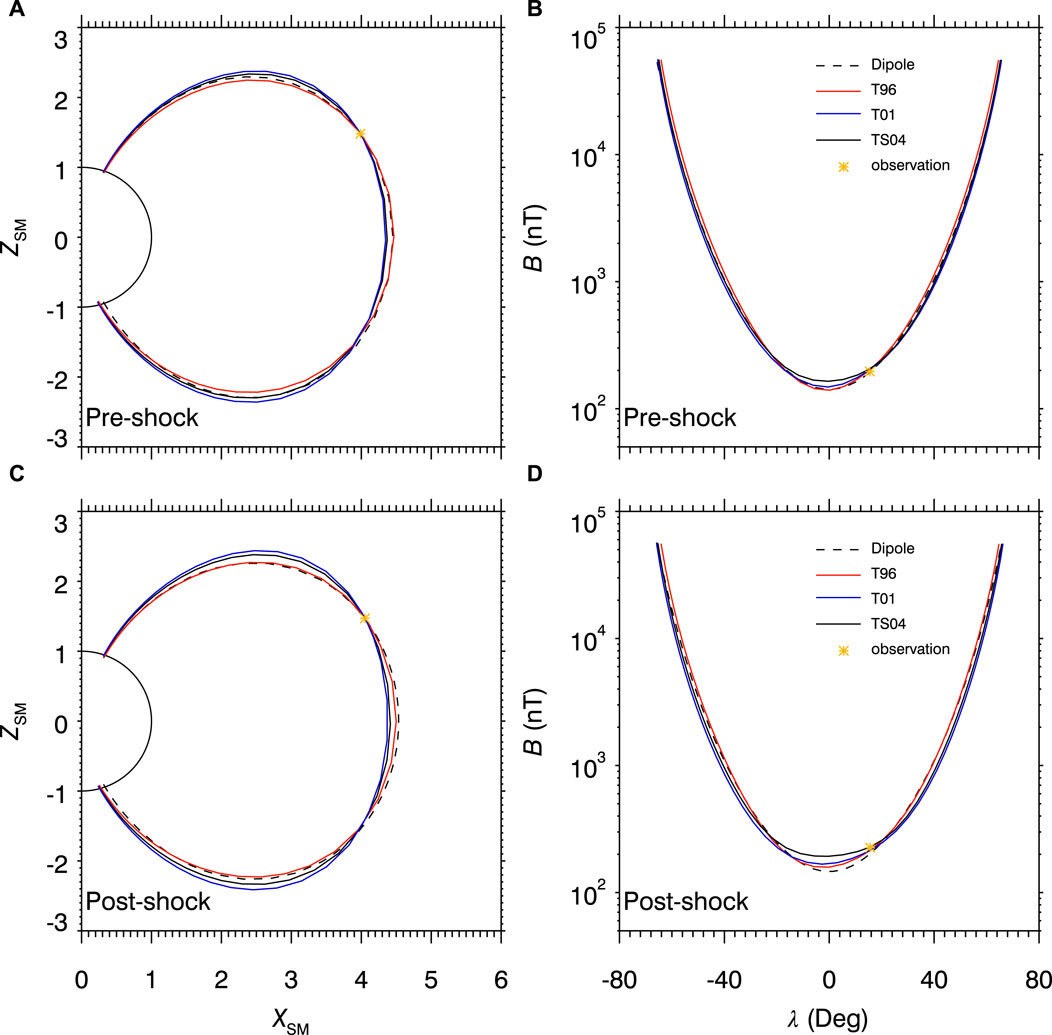
FIGURE 3. Comparison between different geomagnetic models at the pre-shock and post-shock moments on 07 June 2014: (A,C) Modeled magnetic field configurations in the SM X-Z plane along the field lines traced from the RBSP-A location and (B,D) corresponding field intensities as a function of magnetic latitude for dipole (black dashed lines), T96 (red solid lines), T01 (blue solid lines), and TS04 (black solid lines) geomagnetic models. The orange asterisks represent the locations of RBSP-A and observed magnetic field intensities at specific moments.
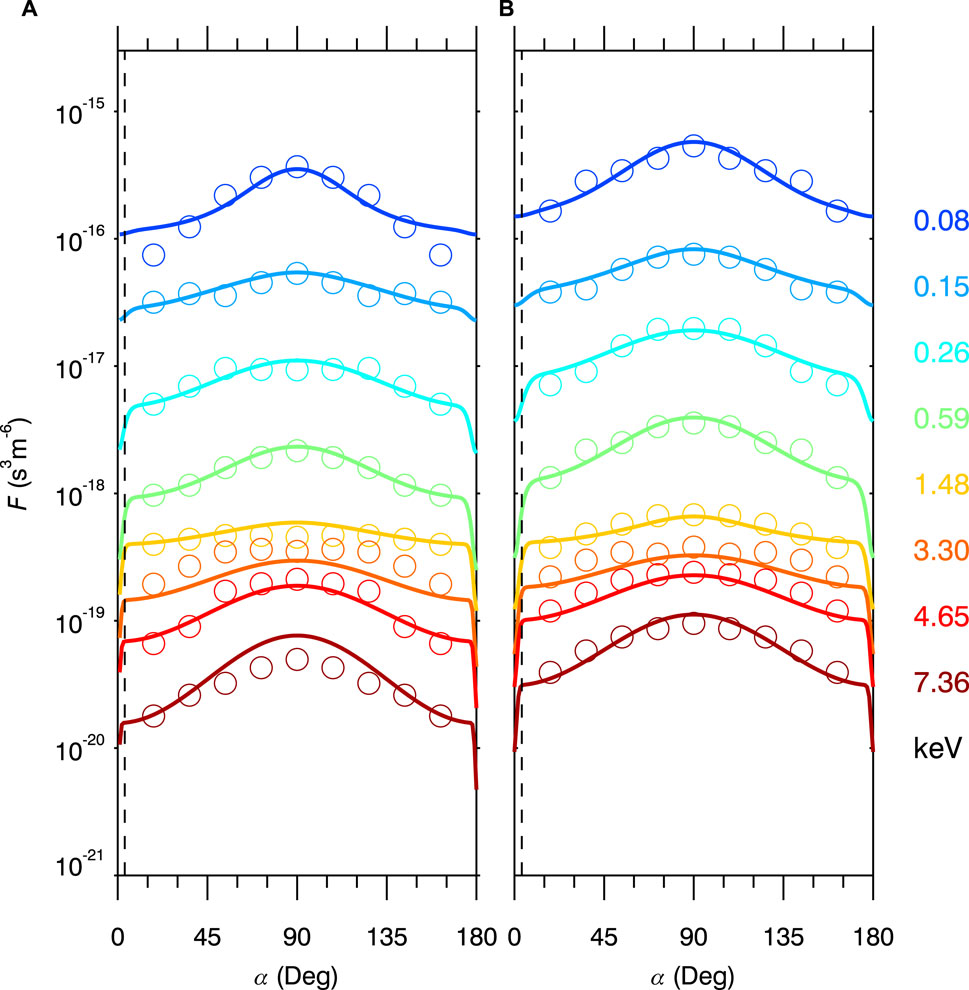
FIGURE 4. Electron phase space densities in pitch angle-energy space at pre-shock (A) and post-shock (B) moments on 07 June 2014. The solid lines and circles represent modeled and observed electron phase space densities, and the black vertical dashed lines represent the modeled loss cone angles.
Figures 5A, D illustrate the ECH wave linear growth rates calculated by the BO code within 87° < θ < 90° at the pre-shock and post-shock moments. Based on the observations (Figure 1H), we focus on the first three harmonic bands below the upper hybrid resonance frequency. It is evident that the modeled growth rates roughly share the similar frequency distributions with the observed ECH wave intensities, indicating the electron phase space density fittings reasonably reflect the real conditions. In comparison to the pre-shock moment, the modeled growth rates at the post-shock moment increase by approximately threefold, qualitatively explaining the intensification of ECH waves after the interplanetary shock. Figures 5B, E show the wave frequency ω/Ωe as a function of normalized wave vector kρe at θ = 89° (ω is the wave angular frequency, Ωe is the electron angular gyrofrequency, and ρe is the gyroradius). These dispersion relations enable the calculation of the wave minimum resonant energy Emin, which can be determined as follows.
here v‖ is the electron parallel velocity, k‖ = k cos θ is the wave parallel vector, n is the resonance order, and me is the electron rest mass. Based on Figures 5B, C, E, F show the minimum resonant energy Emin of different harmonic bands (each with a specific resonance order) as a function of wave frequency ω/Ωe at θ = 89°. Combined with the wave growth rates shown in Figures 5A, D, the corresponding Emin for the frequencies with positive growth rates predominantly falls within the range of 0.1 keV–1 keV. These calculations indicate the ECH wave intensification is highly associated with the shock-induced enhancement of
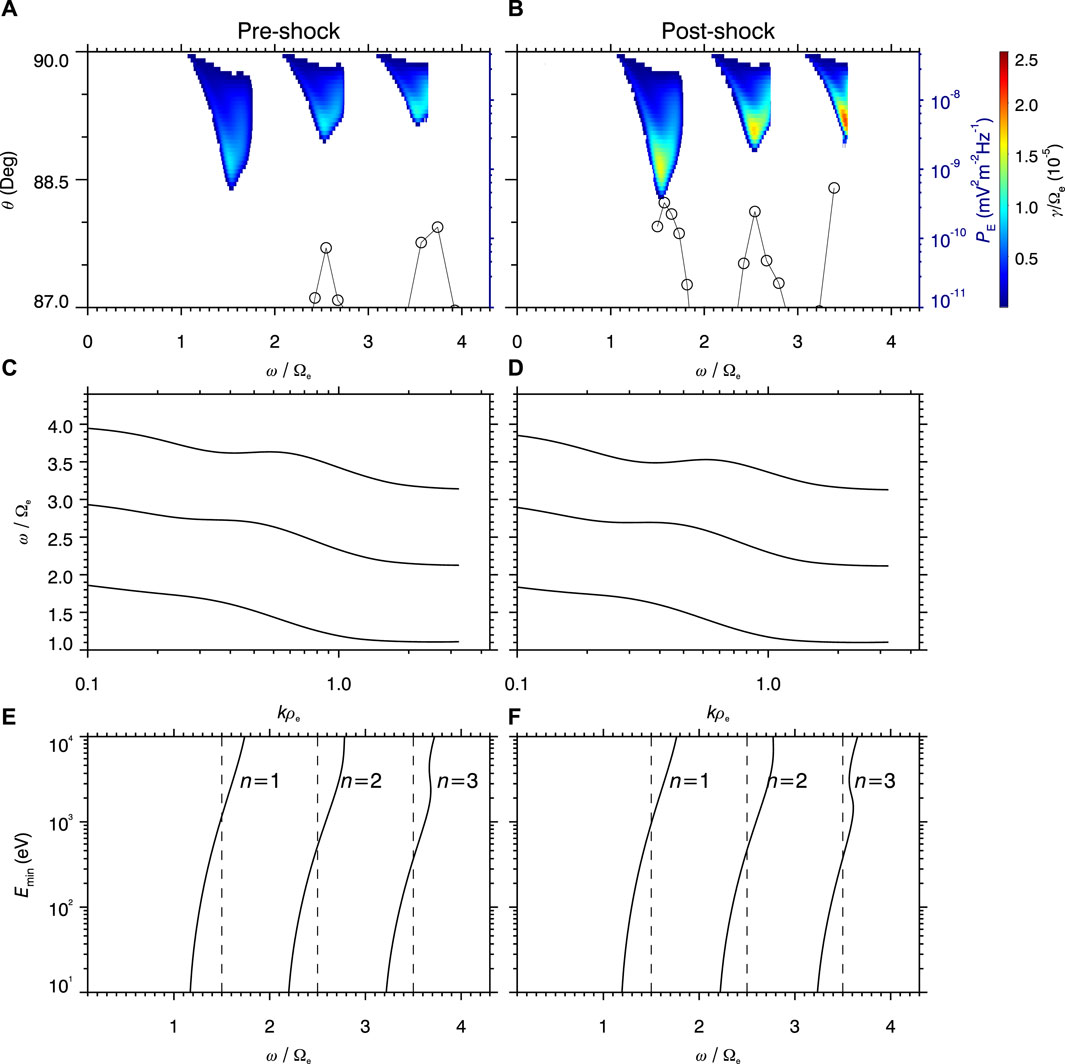
FIGURE 5. ECH wave growth rates, dispersion relations, and minimum resonant energy of first three harmonic bands at pre-shock and post-shock moments. (A,D) linear wave growth rates γ/Ωe as a function of frequency ω/Ωe and wave normal angle θ with overplotted electric power intensity PE of ECH waves from HFR data; (B,E) wave frequency ω/Ωe as a function of normalized wave vector kρe (ρe is the gyroradius) at θ = 89°; (C,F) minimum resonant energy Emin of different harmonic bands (with specific resonance order) as a function of wave frequency ω/Ωe at θ = 89°.
4 Discussion and conclusion
In contrast to previous studies focusing on the dependence of ECH waves on geomagnetic activities [3,25,26,59], here we present the first report of the prompt response of ECH waves to an interplanetary shock based on the WIND and Van Allen Probes observations. A fast forward interplanetary shock with a drastic increase in solar wind dynamic pressure (from 1 nPa to 6 nPa) compressed the Earth’s magnetosphere, causing the prompt intensification of dayside inner magnetospheric ECH waves. The observations and analyses suggest that the shock-induced enhancement of
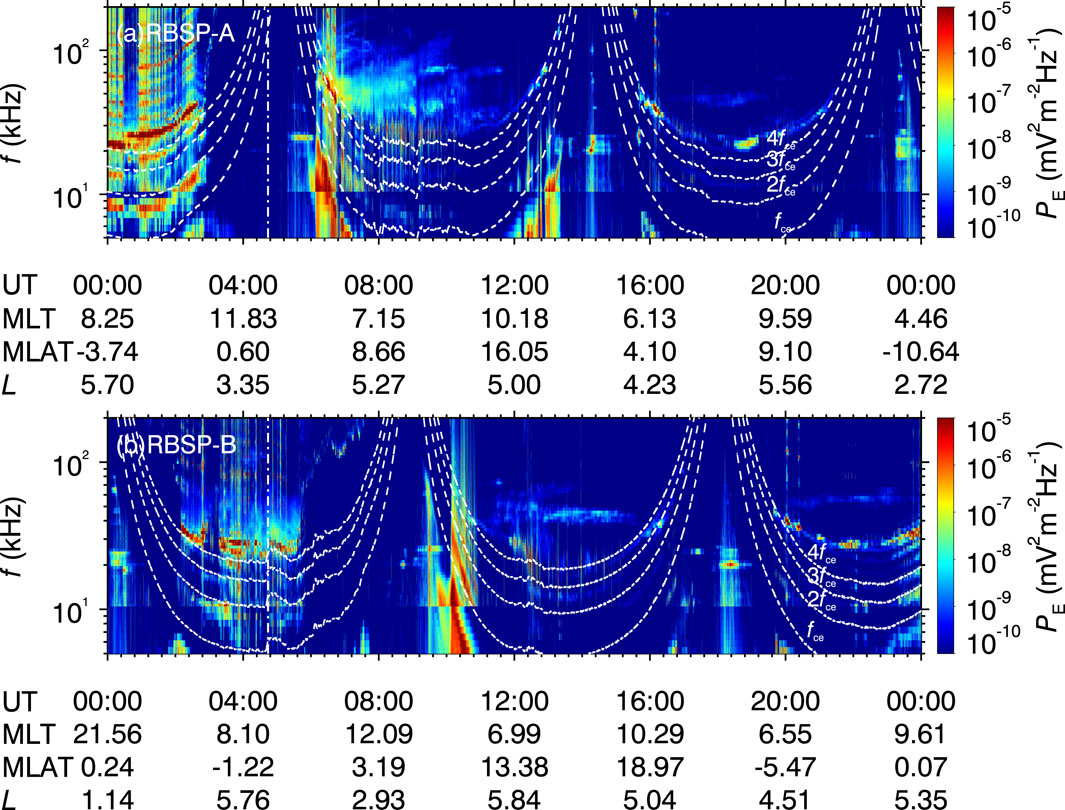
FIGURE 6. Wave electric power spectra PE observed by (A) RBSP-A and (B) RBSP-B on 08 June 2014. The vertical dash-dotted line in (A,B) marks the same moment as the dash-dotted line in Figures 1A–G.
In this work, we employ the BO code to compute the linear wave dispersion relation and growth rate of ECH waves. The calculations are based on the hot electron flux data measured by HOPE. However, as shown in Figure 4, the electron flux data exhibit irregular fluctuations over pitch angles and are notably absent within the loss cone, and the bi-Maxwellian fittings of electron fluxes are unable to capture all the subtle changes. Because of these data and technical limitations, the BO modeling here only provides a qualitative understanding of the observed wave evolutions following the interplanetary shock. In the future, detailed numerical studies are required to evaluate the results obtained in this work.
The prompt responses of magnetospheric waves to solar wind disturbances have attracted increasing interests. Recent works have reported the immediate effects of solar wind disturbances on chorus, hiss, magnetosonic waves, and electromagnetic ion cyclotron waves [36–44,74]. Owing to the important roles of these plasma waves in magnetosphere dynamics, solar wind disturbances could lead to non-negligible changes in space weather by affecting the spatiotemporal distribution of plasma waves. For instance, the ECH wave intensification event reported in this work might contribute to the formation of shock diffuse aurora, attributed to ECH waves’ capacity to scatter keV electrons [75]. Our present findings, in conjunction with previous research, have brought new insights into the solar wind-magnetosphere-ionosphere coupling and highlighted the dependence of magnetospheric waves on the solar wind disturbances.
Data availability statement
The original contributions presented in the study are included in the article/supplementary material, further inquiries can be directed to the corresponding authors.
Author contributions
YX: Data curation, Formal Analysis, Visualization, Writing–review and editing. NL: Data curation, Formal Analysis, Investigation, Methodology, Project administration, Visualization, Writing–original draft. ZS: Funding acquisition, Project administration, Writing–review and editing. SY: Writing–review and editing. ZH: Writing–review and editing. JY: Writing–review and editing. KL: Writing–review and editing. ZC: Writing–review and editing. JC: Writing–review and editing.
Funding
The author(s) declare financial support was received for the research, authorship, and/or publication of this article. This work was supported by the National Natural Science Foundation of China grants 42004140, 42130204, 42188101, and 42274198, the Strategic Priority Research Program of Chinese Academy of Sciences grant XDB 41000000, and the Key Research Program of the Chinese Academy of Sciences grant ZDRE-KT-2021-3.
Conflict of interest
The authors declare that the research was conducted in the absence of any commercial or financial relationships that could be construed as a potential conflict of interest.
Publisher’s note
All claims expressed in this article are solely those of the authors and do not necessarily represent those of their affiliated organizations, or those of the publisher, the editors and the reviewers. Any product that may be evaluated in this article, or claim that may be made by its manufacturer, is not guaranteed or endorsed by the publisher.
References
1. Shaw RR, Gurnett DA. Electrostatic noise bands associated with the electron gyrofrequency and plasma frequency in the outer magnetosphere. J Geophys Res (1975) 80:4259–71. doi:10.1029/JA080i031p04259
2. Roeder JL, Koons HC. A survey of electron cyclotron waves in the magnetosphere and the diffuse auroral electron precipitation. J Geophys Res (1989) 94:2529–41. doi:10.1029/JA094iA03p02529
3. Meredith NP, Horne RB, Thorne RM, Anderson RR. Survey of upper band chorus and ECH waves: implications for the diffuse aurora. J Geophys Res (Space Physics) (2009) 114:A07218. doi:10.1029/2009JA014230
4. Ni B, Thorne R, Liang J, Angelopoulos V, Cully C, Li W, et al. Global distribution of electrostatic electron cyclotron harmonic waves observed on THEMIS. Geophys Res Lett (2011) 38:L17105. doi:10.1029/2011GL048793
5. Liu X, Chen L, Engel MA, Jordanova VK. Global simulation of electron cyclotron harmonic wave instability in a storm-time magnetosphere. Geophys Res Lett (2020) 47:e86368. doi:10.1029/2019GL086368
6. Gao Z, Zuo P, Feng X, Wang Y, Jiang C, Wei F. Evidence of nonlinear interactions between magnetospheric electron cyclotron harmonic waves. Geophys Res Lett (2020) 47:e88452. doi:10.1029/2020GL088452
7. Kennel CF, Scarf FL, Fredricks RW, McGehee JH, Coroniti FV. VLF electric field observations in the magnetosphere. J Geophys Res (1970) 75:6136–52. doi:10.1029/JA075i031p06136
8. Fredricks RW, Scarf FL. Recent studies of magnetospheric electric field emissions above the electron gyrofrequency. J Geophys Res (1973) 78:310–4. doi:10.1029/JA078i001p00310
9. Gurnett DA, Anderson RR, Tsurutani BT, Smith EJ, Paschmann G, Haerendel G, et al. Plasma wave turbulence at the magnetopause: observations from ISEE 1 and 2. J Geophys Res (1979) 84:7043–58. doi:10.1029/JA084iA12p07043
10. Lyons LR. Electron diffusion driven by magnetospheric electrostatic waves. J Geophys Res (1974) 79:575–80. doi:10.1029/JA079i004p00575
11. Horne RB, Thorne RM. Electron pitch angle diffusion by electrostatic electron cyclotron harmonic waves: the origin of pancake distributions. J Geophys Res (2000) 105:5391–402. doi:10.1029/1999JA900447
12. Horne RB, Thorne RM, Meredith NP, Anderson RR. Diffuse auroral electron scattering by electron cyclotron harmonic and whistler mode waves during an isolated substorm. J Geophys Res (2003) 108:1290. doi:10.1029/2002JA009736
13. Ni B, Thorne RM, Horne RB, Meredith NP, Shprits YY, Chen L, et al. Resonant scattering of plasma sheet electrons leading to diffuse auroral precipitation: 1. Evaluation for electrostatic electron cyclotron harmonic waves. J Geophys Res (2011) 116:A04218. doi:10.1029/2010JA016232
14. Tao X, Thorne RM, Li W, Ni B, Meredith NP, Horne RB. Evolution of electron pitch angle distributions following injection from the plasma sheet. J Geophys Res (2011) 116:A04229. doi:10.1029/2010ja016245
15. Zhang X, Angelopoulos V, Ni B, Thorne RM, Horne RB. Quasi-steady, marginally unstable electron cyclotron harmonic wave amplitudes. J Geophys Res (Space Physics) (2013) 118:3165–72. doi:10.1002/jgra.50319
16. Yang Q, Liu S, Yang H, Zhang S, Tang J, Xiao F, et al. Efficient scattering loss of energetic electrons by enhanced higher-band ECH waves observed by van allen probes. Geophys Res Lett (2023) 50:e2023GL103927. doi:10.1029/2023GL103927
17. Shprits YY, Subbotin D, Ni B. Evolution of electron fluxes in the outer radiation belt computed with the VERB code. J Geophys Res (2009) 114:A11209. doi:10.1029/2008JA013784
18. Su Z, Xiao F, Zheng H, Wang S. STEERB: a three-dimensional code for storm-time evolution of electron radiation belt. J Geophys Res (2010) 115:A09208. doi:10.1029/2009JA015210
19. Su Z, Xiao F, Zheng H, Wang S. CRRES observation and STEERB simulation of the 9 October 1990 electron radiation belt dropout event. Geophys Res Lett (2011) 38:L06106. doi:10.1029/2011GL046873
20. Tu W, Cunningham GS, Chen Y, Henderson MG, Camporeale E, Reeves GD. Modeling radiation belt electron dynamics during GEM challenge intervals with the DREAM3D diffusion model. J Geophys Res (2013) 118:6197–211. doi:10.1002/jgra.50560
21. Glauert SA, Horne RB, Meredith NP. Three-dimensional electron radiation belt simulations using the BAS Radiation Belt Model with new diffusion models for chorus, plasmaspheric hiss, and lightning-generated whistlers. J Geophys Res (2014) 119:268–89. doi:10.1002/2013JA019281
22. Ni B, Thorne RM, Zhang X, Bortnik J, Pu Z, Xie L, et al. Origins of the Earth’s diffuse auroral precipitation. Space Sci Rev (2016) 200:205–59. doi:10.1007/s11214-016-0234-7
23. Ashour-Abdalla M, Kennel C. Nonconvective and convective electron cyclotron harmonic instabilities. J Geophys Res (1978) 83:1531–43. doi:10.1029/JA083iA04p01531
24. Horne RB. Path-integrated growth of electrostatic waves: the generation of terrestrial myriametric radiation. J Geophys Res (1989) 94:8895–909. doi:10.1029/JA094iA07p08895
25. Ni B, Gu X, Fu S, Xiang Z, Lou Y. A statistical survey of electrostatic electron cyclotron harmonic waves based on THEMIS FFF wave data. J Geophys Res (Space Physics) (2017) 122:3342–53. doi:10.1002/2016JA023433
26. Liu X, Chen L, Xia Z. The relation between electron cyclotron harmonic waves and plasmapause: case and statistical studies. Geophys Res Lett (2020) 47:e2020GL087365. doi:10.1029/2020GL087365
27. Liu S, Chen Y, Yang Q, Yang H, Xiao F, Wang B, et al. Statistical study on spatial distribution of frequency-chirping ech elements by van allen probes. Geophys Res Lett (2023) 50:e2023GL106371. doi:10.1029/2023GL106371
28. Colburn DS, Sonett CP. Discontinuities in the solar wind. Space Sci Rev (1966) 5:439–506. doi:10.1007/BF00240575
29. Hudson PD. Discontinuities in an anisotropic plasma and their identification in the solar wind. Planet Space Sci (1970) 18:1611–22. doi:10.1016/0032-0633(70)90036-X
30. Greco A, Perri S, Servidio S, Yordanova E, Veltri P. The complex structure of magnetic field discontinuities in the turbulent solar wind. Astrophys J Lett (2016) 823:L39. doi:10.3847/2041-8205/823/2/L39
31. Artemyev AV, Angelopoulos V, Vasko IY, Runov A, Avanov LA, Giles BL, et al. On the kinetic nature of solar wind discontinuities. Geophys Res Lett (2019) 46:1185–94. doi:10.1029/2018GL079906
32. Russell CT, Ginskey M, Petrinec SM. Sudden impulses at low-latitude stations: steady state response for northward interplanetary magnetic field. J Geophys Res (1994) 99:253–61. doi:10.1029/93JA02288
33. Borodkova NL, Zastenker GN, Sibeck DG. A case and statistical study of transient magnetic field events at geosynchronous orbit and their solar wind origin. J Geophys Res (1995) 100:5643–56. doi:10.1029/94JA03144
34. Lyon JG. The solar wind-magnetosphere-ionosphere system. Science (2000) 288:1987–91. doi:10.1126/science.288.5473.1987
35. Zuo P, Feng X, Xie Y, Wang Y, Li H, Xu X. Automatic detection algorithm of dynamic pressure pulses in the solar wind. Astrophysical J (2015) 803:94. doi:10.1088/0004-637X/803/2/94
36. Fu HS, Cao JB, Mozer FS, Lu HY, Yang B. Chorus intensification in response to interplanetary shock. J Geophys Res (2012) 117:A01203. doi:10.1029/2011JA016913
37. Su Z, Zhu H, Xiao F, Zheng H, Wang Y, Shen C, et al. Disappearance of plasmaspheric hiss following interplanetary shock. Geophys Res Lett (2015) 42:3129–40. doi:10.1002/2015GL063906
38. Liu N, Su Z, Gao Z, Reeves GD, Zheng H, Wang Y, et al. Shock-induced disappearance and subsequent recovery of plasmaspheric hiss: coordinated observations of RBSP, THEMIS, and POES satellites. J Geophys Res (Space Physics) (2017) 122:10. doi:10.1002/2017JA024470
39. Liu N, Su Z, Zheng H, Wang Y, Wang S. Prompt disappearance and emergence of radiation belt magnetosonic waves induced by solar wind dynamic pressure variations. Geophys Res Lett (2018) 45:585–94. doi:10.1002/2017GL076382
40. Zhou C, Li W, Thorne RM, Bortnik J, Ma Q, An X, et al. Excitation of dayside chorus waves due to magnetic field line compression in response to interplanetary shocks. J Geophys Res (Space Physics) (2015) 120:8327–38. doi:10.1002/2015JA021530
41. Yue C, Chen L, Bortnik J, Ma Q, Thorne RM, Angelopoulos V, et al. The characteristic response of whistler mode waves to interplanetary shocks. J Geophys Res (Space Physics) (2017) 122(10). 047057. doi:10.1002/2017JA024574
42. Fu H, Yue C, Ma Q, Kang N, Bortnik J, Zong Q-g., et al. Frequency-dependent responses of plasmaspheric hiss to the impact of an interplanetary shock. Geophys Res Lett (2021) 48:e2021GL094810. doi:10.1029/2021GL094810
43. Jin Y, Liu N, Su Z, Zheng H, Wang Y, Wang S. Immediate impact of solar wind dynamic pressure pulses on whistler-mode chorus waves in the inner magnetosphere. Geophys Res Lett (2022) 49:e2022GL097941. doi:10.1029/2022GL097941
44. Liu N, Su Z. Prompt responses of magnetospheric whistler-mode waves to solar wind dynamic pressure pulses. Front Astron Space Sci (2023) 10. doi:10.3389/fspas.2023.1193600
45. Ogilvie K, Desch M. The wind spacecraft and its early scientific results. Adv Space Res (1997) 20:559–68. doi:10.1016/s0273-1177(97)00439-0
46. Mauk BH, Fox NJ, Kanekal SG, Kessel RL, Sibeck DG, Ukhorskiy A. Science objectives and rationale for the radiation belt storm probes mission. Space Sci Rev (2013) 179:3–27. doi:10.1007/s11214-012-9908-y
47. Ogilvie KW, Chornay DJ, Fritzenreiter RJ, Hunsaker F, Keller J, Lobell J, et al. SWE, A comprehensive plasma instrument for the wind spacecraft. Space Sci Rev (1995) 71:55–77. doi:10.1007/BF00751326
48. Lepping RP, Acũna MH, Burlaga LF, Farrell WM, Slavin JA, Schatten KH, et al. The wind magnetic field investigation. Space Sci Rev (1995) 71:207–29. doi:10.1007/BF00751330
49. Lin RP, Anderson KA, Ashford S, Carlson C, Curtis D, Ergun R, et al. A three-dimensional plasma and energetic particle investigation for the wind spacecraft. Space Sci Rev (1995) 71:125–53. doi:10.1007/BF00751328
50. Kletzing CA, Kurth WS, Acuna M, MacDowall RJ, Torbert RB, Averkamp T, et al. The electric and magnetic field instrument suite and integrated science (EMFISIS) on RBSP. Space Sci Rev (2013) 179:127–81. doi:10.1007/s11214-013-9993-6
51. Kurth WS, Pascuale SD, Faden JB, Kletzing CA, Hospodarsky GB, Thaller S, et al. Electron densities inferred from plasma wave spectra obtained by the waves instrument on van allen probes. J Geophys Res (2014) 120:904–14. doi:10.1002/2014JA020857
52. Wygant J, Bonnell J, Goetz K, Ergun R, Mozer F, Bale S, et al. The electric field and waves instruments on the radiation belt storm probes mission. Space Sci Rev (2013) 179:183–220. doi:10.1007/s11214-013-0013-7
53. Funsten HO, Skoug RM, Guthrie AA, MacDonald EA, Baldonado JR, Harper RW, et al. Helium, oxygen, proton, and electron (HOPE) mass spectrometer for the radiation belt storm probes mission. Space Sci Rev (2013) 179:423–84. doi:10.1007/s11214-013-9968-7
54. Spence HE, Reeves GD, Baker DN, Blake JB, Bolton M, Bourdarie S, et al. Science goals and overview of the energetic particle, composition, and thermal plasma (ECT) suite on NASA’s Radiation Belt Storm Probes (RBSP) mission. Space Sci Rev (2013) 179:311–36. doi:10.1007/s11214-013-0007-5
55. Chi Y, Shen C, Wang Y, Xu M, Ye P, Wang S. Statistical study of the interplanetary coronal mass ejections from 1995 to 2015. Solar Phys (2016) 291:2419–39. doi:10.1007/s11207-016-0971-5
56. Zurbuchen TH, Richardson IG. In-situ solar wind and magnetic field signatures of interplanetary coronal mass ejections. Space Sci Rev (2006) 123:31–43. doi:10.1007/s11214-006-9010-4
57. Wu C-C, Lepping RP. Statistical comparison of magnetic clouds with interplanetary coronal mass ejections for solar cycle 23. Solar Phys (2011) 269:141–53. doi:10.1007/s11207-010-9684-3
58. Kilpua EKJ, Lumme E, Andreeova K, Isavnin A, Koskinen HEJ. Properties and drivers of fast interplanetary shocks near the orbit of the Earth (1995-2013). J Geophys Res (Space Physics) (2015) 120:4112–25. doi:10.1002/2015JA021138
59. Lou Y, Gu X, Summers D, Ni B, Liu K, Fu S, et al. Statistical distributions of dayside ECH waves observed by MMS. Geophys Res Lett (2018) 45(12):738. 730–12. doi:10.1029/2018GL080125
60. Yu J, Wang J, Chen Z, Ren A, Liu X, Liu N, et al. Statistical evidence for off-equatorial minimum-B-pocket as a source region of electron cyclotron harmonic waves in the dayside outer magnetosphere. Geophys Res Lett (2023) 50:e2022GL102583. doi:10.1029/2022GL102583
61. Zong Q, Zhou X, Wang YF, Li X, Song P, Baker DN, et al. Energetic electron response to ULF waves induced by interplanetary shocks in the outer radiation belt. J Geophys Res (2009) 114:A10204. doi:10.1029/2009JA014393
62. Foster JC, Wygant JR, Hudson MK, Boyd AJ, Baker DN, Erickson PJ, et al. Shock-induced prompt relativistic electron acceleration in the inner magnetosphere. J Geophys Res Accepted (2015) 120:1661–74. doi:10.1002/2014JA020642
63. Ren J, Zong QG, Miyoshi Y, Zhou XZ, Wang YF, Rankin R, et al. Low-energy (<200 eV) electron acceleration by ULF waves in the plasmaspheric boundary layer: van allen probes observation. J Geophys Res (Space Physics) (2017) 122:9969–82. doi:10.1002/2017JA024316
64. Ren J, Zong QG, Zhou XZ, Spence HE, Funsten HO, Wygant JR, et al. Cold plasmaspheric electrons affected by ULF waves in the inner magnetosphere: a van allen probes statistical study. J Geophys Res (Space Physics) (2019) 124:7954–65. doi:10.1029/2019JA027009
65. Ma X, Tian AM, Shi QQ, Bai SC, Yao ST, Shen XC, et al. Electron pitch angle distributions in compressional Pc5 waves by THEMIS-A observations. Geophys Res Lett (2021) 48:e95730. doi:10.1029/2021GL095730
66. Xie H, Xiao Y. PDRK: a general kinetic dispersion relation solver for magnetized plasma. Plasma Sci Tech (2016) 18:97–107. doi:10.1088/1009-0630/18/2/01
67. Zhou Q, Xiao F, Yang C, Liu S, He Y, Baker DN, et al. Generation of lower and upper bands of electrostatic electron cyclotron harmonic waves in the Van Allen radiation belts. Geophys Res Lett (2017) 44:5251–8. doi:10.1002/2017GL073051
68. Lou Y, Cao X, Ni B, Tu W, Gu X, Fu S, et al. Diffuse auroral electron scattering by electrostatic electron cyclotron harmonic waves in the dayside magnetosphere. Geophys Res Lett (2021) 48:e92208. doi:10.1029/2020GL092208
70. Tsyganenko NA, Stern DP. Modeling the global magnetic field of the large-scale Birkeland current systems. J Geophys Res (1996) 101:27187–98. doi:10.1029/96JA02735
71. Tsyganenko NA. A model of the near magnetosphere with a dawn-dusk asymmetry 1. mathematical structure. J Geophys Res Space Phys (2002) 107. SMP 12–1–SMP 12–15. doi:10.1029/2001JA000219
72. Tsyganenko NA, Sitnov MI. Modeling the dynamics of the inner magnetosphere during strong geomagnetic storms. J Geophys Res (2005) 110:A03208. doi:10.1029/2004JA010798
73. Boudouridis A, Lyons LR, Zesta E, Ruohoniemi JM. Dayside reconnection enhancement resulting from a solar wind dynamic pressure increase. J Geophys Res (Space Physics) (2007) 112:A06201. doi:10.1029/2006JA012141
74. Liu N, Su Z, Gao Z, Zheng H, Wang Y, Wang S. Can solar wind decompressive discontinuities suppress magnetospheric electromagnetic ion cyclotron waves associated with fresh proton injections? Geophys Res Lett (2020) 47:e90296. doi:10.1029/2020GL090296
Keywords: interplanetary shock, electron cyclotron harmonic wave, solar wind-magnetosphere-ionosphere coupling, inner magnetosphere, plasma wave instability
Citation: Xie Y, Liu N, Su Z, Yi S, He Z, Yu J, Li K, Chen Z and Cui J (2024) Interplanetary shock induced intensification of electron cyclotron harmonic waves in the Earth’s inner magnetosphere. Front. Phys. 12:1334531. doi: 10.3389/fphy.2024.1334531
Received: 07 November 2023; Accepted: 25 January 2024;
Published: 07 February 2024.
Edited by:
Boyi Wang, Harbin Institute of Technology, Shenzhen, ChinaReviewed by:
Xiaochen Shen, Boston University, United StatesXochitl Blanco-Cano, National Autonomous University of Mexico, Mexico
Copyright © 2024 Xie, Liu, Su, Yi, He, Yu, Li, Chen and Cui. This is an open-access article distributed under the terms of the Creative Commons Attribution License (CC BY). The use, distribution or reproduction in other forums is permitted, provided the original author(s) and the copyright owner(s) are credited and that the original publication in this journal is cited, in accordance with accepted academic practice. No use, distribution or reproduction is permitted which does not comply with these terms.
*Correspondence: Nigang Liu, bGl1bmc1QG1haWwuc3lzdS5lZHUuY24=; Zhenpeng Su, c3pwZUBtYWlsLnVzdGMuZWR1LmNu
 Yi Xie1,2
Yi Xie1,2 Nigang Liu
Nigang Liu Zhenpeng Su
Zhenpeng Su Siyang Yi
Siyang Yi Zhaoguo He
Zhaoguo He Jiang Yu
Jiang Yu Kun Li
Kun Li